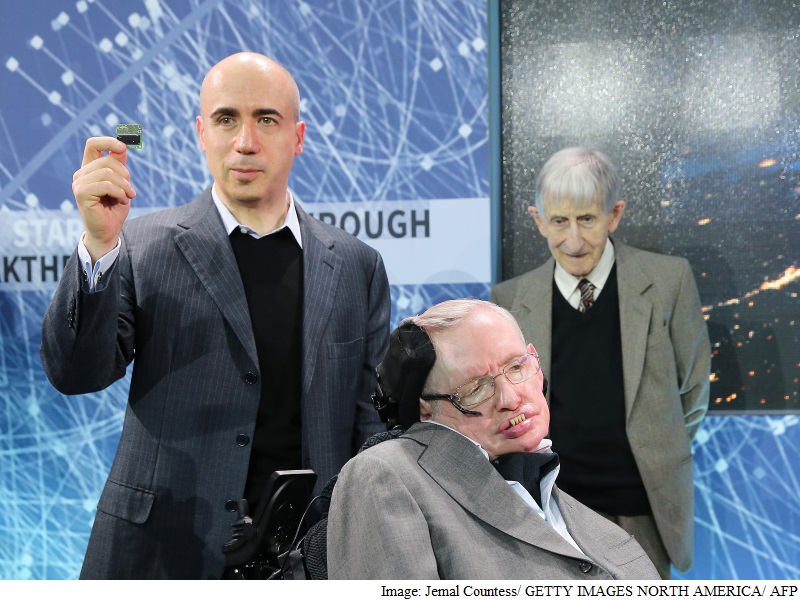- Home
- Science
- Science News
- Hawking, Milner, and Zuckerberg Invest in Interstellar Spaceships
Hawking, Milner, and Zuckerberg Invest in Interstellar Spaceships

Hawking and Milner made the joint announcement at a press conference held at One World Observatory in New York City on Tuesday, Xinhua reported.
The project, dubbed "Breakthrough Starshot," is a research and engineering programme that aims to build laser beam propelled "nanocrafts" that can travel at 20 percent of lightspeed - more than 1,000 times faster than current fastest spacecraft.
According to Milner, once the "nanocrafts" are built, they could reach Alpha Centauri, a star 4.37 light-years away, approximately 20 years in a fly-by mission.
Alpha Centauri is one of the closest star systems to the solar system and the current fastest spacecraft would have to spend 30,000 years to get there.
The "nanocrafts" are gram-scale robotic spacecrafts consisting of two main parts: a computer CPU sized "StarChip" and a "Lightsail" made with metamaterials no more than a few hundred atoms thick.
Although weighing just a few grams, the "StarChip" is a fully functional space probe, which carries various equipment including cameras, navigation and communication.
"The 'StarChip' can be mass-produced at the cost of an iPhone," Milner said.
The "nanocrafts" can then be propelled into space by a powerful laser beam, which according to Avi Loeb, a theoretical physicist and panellist at the news conference, will carry a power of 100 gigawatt.
"This is the power needed to lift off a space shuttle," Loeb said.
Milner and the scientists believe that with the rising power and falling costs of lasers, the entire process is practical within a couple of years.
"Fifteen years ago, it would not have made sense to make this investment. Now we have looked at the numbers, and it does," Milner said.
The project was part of the Breakthrough Initiatives first launched in July 2015 by Hawking and Milner, including a series of research plans to scan the 100 galaxies closest to the Milky Way in search for aliens. "Starshot" is its newest endeavour.
Hawking believes that human's innate sense to transcend limits is the driving force behind the project. "Gravity pins us to the ground, but I just flew to America."
While one cannot hear the joking tone through Hawking's voice synthesizer, his humour had been easily received.
What the scientists are looking for is not just reaching Alpha Centauri, but what can be learned during the efforts.
"A lot of science will be learned by the process of going through this, making this happen," said panelist Mae Jemison, a former Nasa astronaut.
"There is big task ahead, there's a big leap in getting something of a micro size to go at some percentage of the speed of light. That will have all kinds of reverberations."
Tuesday also marked the 55th anniversary of the first human space flight by Russian cosmonaut Yuri Gagarin.
"Today we commit to this next great leap into the cosmos because we are human and our nature is to fly," Hawking said.
Catch the latest from the Consumer Electronics Show on Gadgets 360, at our CES 2026 hub.
Related Stories
- Samsung Galaxy Unpacked 2025
- ChatGPT
- Redmi Note 14 Pro+
- iPhone 16
- Apple Vision Pro
- Oneplus 12
- OnePlus Nord CE 3 Lite 5G
- iPhone 13
- Xiaomi 14 Pro
- Oppo Find N3
- Tecno Spark Go (2023)
- Realme V30
- Best Phones Under 25000
- Samsung Galaxy S24 Series
- Cryptocurrency
- iQoo 12
- Samsung Galaxy S24 Ultra
- Giottus
- Samsung Galaxy Z Flip 5
- Apple 'Scary Fast'
- Housefull 5
- GoPro Hero 12 Black Review
- Invincible Season 2
- JioGlass
- HD Ready TV
- Laptop Under 50000
- Smartwatch Under 10000
- Latest Mobile Phones
- Compare Phones
- Tecno Spark Go 3
- iQOO Z11 Turbo
- OPPO A6c
- Samsung Galaxy A07 5G
- Vivo Y500i
- OnePlus Turbo 6V
- OnePlus Turbo 6
- Itel Zeno 20 Max
- Lenovo Yoga Slim 7x (2025)
- Lenovo Yoga Slim 7a
- Lenovo Idea Tab Plus
- Realme Pad 3
- Garmin Quatix 8 Pro
- NoiseFit Pro 6R
- Haier H5E Series
- Acerpure Nitro Z Series 100-inch QLED TV
- Asus ROG Ally
- Nintendo Switch Lite
- Haier 1.6 Ton 5 Star Inverter Split AC (HSU19G-MZAID5BN-INV)
- Haier 1.6 Ton 5 Star Inverter Split AC (HSU19G-MZAIM5BN-INV)

















